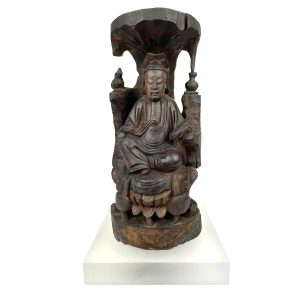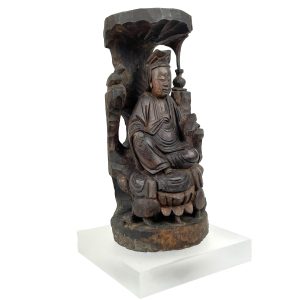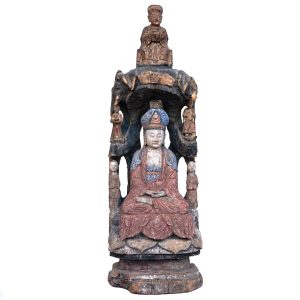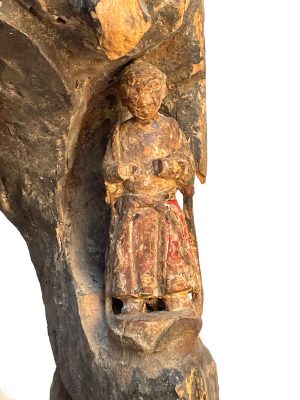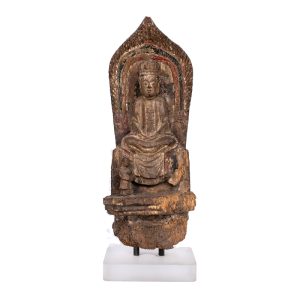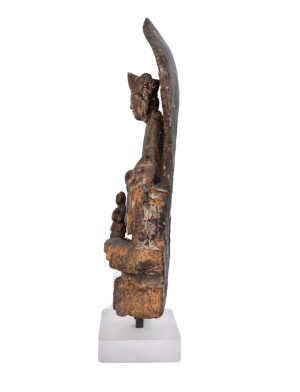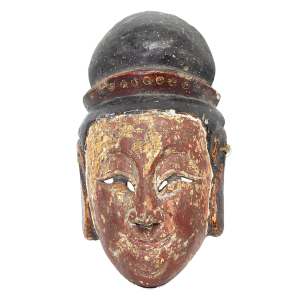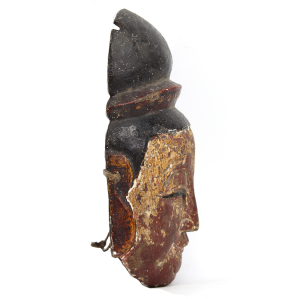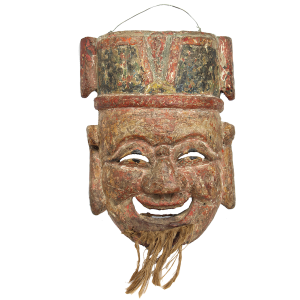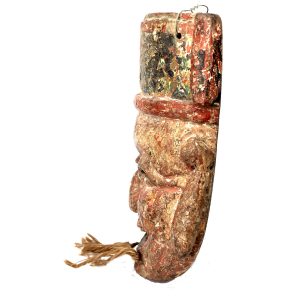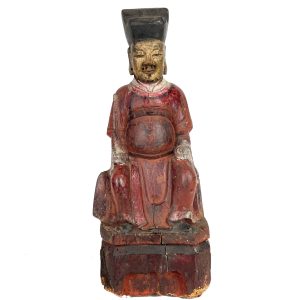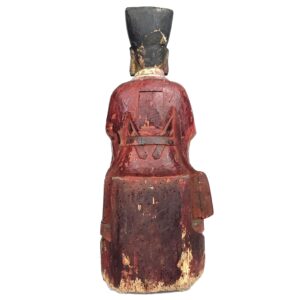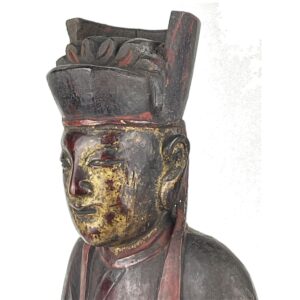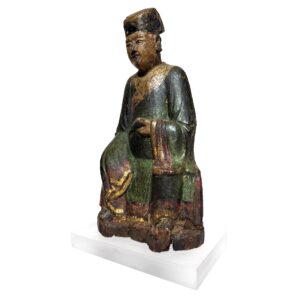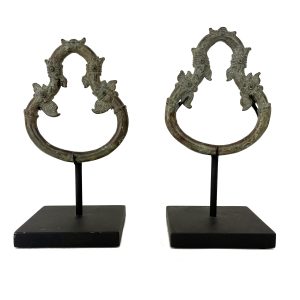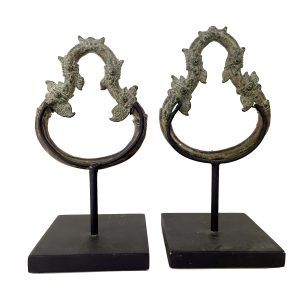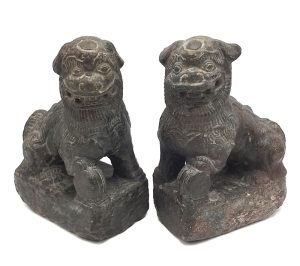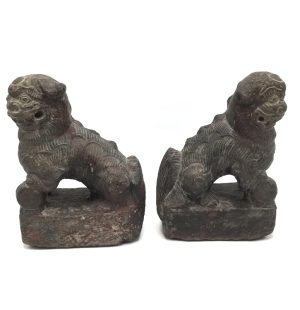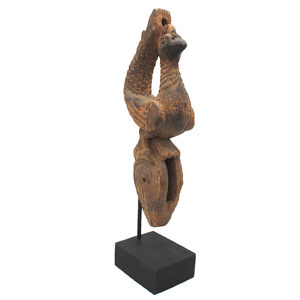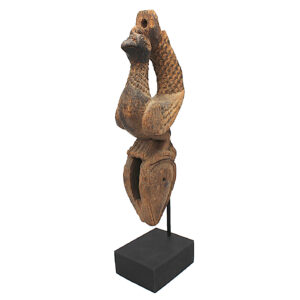Showing 121–132 of 313 results
-


$750.00
As one of the most popular Mahayana Pure Land images, especially during the Ming and Qing dynasties, this antique Chinese wood carving of Nanhai Guanyin of the Southern Seas is seated on a symbolic craggy rock outcrop below an arch of draped moss (some of which is missing ) at the entrance to the Tidal…
-


$5,900.00
This Nanhai Guanyin sits in her cave home on the island of Putuo represented by pierced openwork, craggy surfaces and open area at the cave top. Guanyin’s image almost fills the cave’s opening seated in dhyana (meditation), thumbs forming a triangle symbolizing the triratna, the Three Gems of Buddhism (the Buddha, the Dharma (Buddha’s teachings)…
-


$720.00
Nanhai-Guanyin seated in meditation (dhyana mudra) in her Tidal Cave on Putuo is one of the most popular Mahayana Pure Land Guanyin images, especially during the Ming and Qing dynasties, and strongly reflects the Chinese syncretic blending of religious beliefs. Provincial craftsmen portrayed her in to reflect local beliefs, lifestyles and customs that resonated with…
-


$395.00
The origins of Nuo Opera, performed in provincial villages in Southern China since antiquity, is found in spirit and ancestor worship and Taoism. Performances use a few dozen to 200 masks having distinctive facial features, decorations, regional and ethnic individuality and aesthetic diversity. Usually carved from poplar or willow which are light and less likely…
-


$575.00
H: 10.5” W:7.75” D: 3” | FREE SHIPPING!
This amusing antique Nuo Opera mask portrays Tudi Gong, the benevolent Earth god with a smiling animated face, long eyebrows, a hemp beard and large ears wearing a high decorative hat. Tudi is a zhengshen, a god who is kindly, honest with a gentle disposition, symbolizing the great power of good, through which evil can be defeated. Nuo was popular during the Ming and Qing dynasties and although they are still performed in rural areas, there are few remaining troupes.
-
Sale!


$875.00 Original price was: $875.00.$475.00Current price is: $475.00.
H: 15.5″ W: 6.125 ” 4.125 D: ” | FREE SHIPPING WITHIN CONTINENTAL U.S.!
This carved ancestor figure portrayed as an official sits on a backless chair with a decorative pedestal in official’s attire: a high collared red robe, double belt above and below his ample stomach and holding a long slender curved hu-tablet, all signs of his office and status. He is vibrantly painted in red, the color of fu, as a wish for prosperity and status.
-


$985.00
H: 15″ W: 6.5″ D: 5.5″ | EMAIL [email protected] OR CALL 213-568-3030 FOR SHIPPING COST
This excellently carved civilian official with gilt highlights was commissioned by a family to place on a home altar for veneration and to impress those who viewed it. The imposing ancestor figure grasps his belt of office to show his pride in passing examinations to become a civil official, which leads to a life of rank and prosperity for him and his family. Statues like this are an affirmation of persistence, success, status and power and they honor those who display these characteristics.
-


$535.00
H: 19″ W: 10″ D: 8″ | CALL 213-568-3030 OR EMAIL [email protected] for shipping INFORMATION.
This wonderfully carved Nanhai Guanyin statue is notable for its highly ornate and beautiful diadem centered by an elaborately framed image of Buddha Amitabha seated in meditation. Her vibrant aura radiates spirituality and opulence, serenity and strength, as well as compassion and grace, making this statue a truly masterful piece of art.
-
Sale!


$650.00 Original price was: $650.00.$450.00Current price is: $450.00.
H: 7.75” W: 3.5″ D: 3.5″ | FREE SHIPPING within continental U.S.!
This unique pair of attendants was likely placed on a home altar flanking and looking slightly inward to a Buddhist or Taoist figure or deity. Standing on circular pedestals, they smile slightly with down cast eyes presenting boxed offerings. One box has ribbons symbolizing the object’s miraculous powers and a wish for longevity. Rare to find pairs of charming figurines, they look even better on custom frosted Acrylic stands.
-
Sale!


$1,350.00 Original price was: $1,350.00.$950.00Current price is: $950.00.
Each H:4.675 ” W:3.875 ” D:.5 ” | FREE SHIPPING WITHIN CONTINENTAL U.S.!
This pair of 12-13th century bronze rings was used to hold poles attached a litter bed or chair held on shoulders of carriers, usually to transport people of royal or elite status in Khmer Empire society. The narrow upper body, which is decorated with a lotus motif, was used to hold a bronze hook and the lower body to accommodate the pole. Although possibly made in Cambodia the Khmer Empire’s center, it was found in Lopburi, Thailand, the western most Khmer outpost
-


$695.00
H: 8” W: 5.5” D: 3.25” | FREE SHIPPING WITHIN CONTINENTAL U.S.!
This is a really great pair of stone small fu lions with lots of character, humor, and detailed carving. Each of these very joyous creatures has open mouthed smiling faces with radiant eyebrows and tufts below their chins, scalloped manes and bushy tails. Carved from one piece of a blackish hard stone they could easily withstand additional wear of the elements in a garden. Pairs of fu lions like this belong in the home of people who appreciate spirituality and wish for happiness and fortune along with a touch of wit and whimsy.
-
Sale!


$245.00 Original price was: $245.00.$150.00Current price is: $150.00.
H: 13” W: 3.75” D: 2.625” | FREE SHIPPING WITHIN CONTINENTAL U.S.
This Burmese teak heddle pulley is topped by a graceful peacock. The peacock symbolizes wholeness, combining all colors with its spread tail and the fleeting nature of all sentient beings. Drawing on old animistic beliefs, old folk art Burmese heddles are decorated with carvings of mythical or auspicious animals providing the weaver protection and assuring good quality weaving. Mounted on wood base.
End of content
End of content

